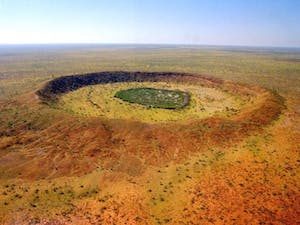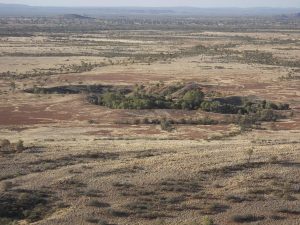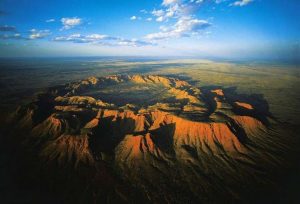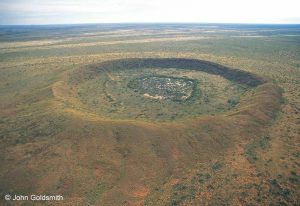Meteorite Craters

Henbury

Around 4,200 years ago, a large nickel-iron meteoroid came blazing across the Central Australian sky. It broke apart before striking the ground 145km south of what is now Alice Springs. The fragments carved out more than a dozen craters up to 180 meters across with the energy of a small nuclear explosion. Today, we call this place the Henbury Meteorites Conservation Reserve.
Aboriginal people have inhabited the region for tens-of-thousands of years, and it’s almost certain they witnessed this dramatic event. But did an oral record of this event survive to modern times? When scientists first visited Henbury in 1931, they brought with them an Aboriginal guide. When they ventured near the site, the guide would go no further. He said his people were forbidden from going near the craters, as that was where the fire-devil ran down from the sun and set the land ablaze, killing people and forming the giant holes. They were also forbidden from collecting water that pooled in the craters, as they feared the fire-devil would fill them with a piece of iron.
The following year, a local resident asked Luritja elders about the craters. The elders provided the same answer and said the fire-devil “will burn and eat” anyone who breaks sacred law, as he had done long ago. Thus, the story of Henbury indicates a living memory of an event that occurred over four thousand years ago.
Gosses Bluff (Tnorala)

175 km west of Alice Springs lies a 5 km-wide ring-shaped mountain range that stands 150 metres above the desert. Geologists call it Gosses Bluff, but the Western Arrente call this place Tnorala and consider it sacred. Aunty Mavis Malbunka, the Traditional Custodian of Tnorala, explains the origin of feature in Arrernte traditions.
In the Dreaming, a group of sky-women danced as stars in the Milky Way. One of the women, who was carrying a baby, grew tired and placed her baby in a wooden basket, called a turna or coolamon. As the women continued dancing, the turna fell and the baby plunged into the earth. The baby struck the earth and was covered by the turna, the force of which drove the rocks upward, forming the circular mountain range we see today. The baby’s mother, the evening star, and father, the morning star, continue to search for their baby to this day. She continues:
“We tell the children don’t look at the evening star or the morning star, they will make you sick because these two stars are still looking for their little baby that they lost during the dance up there in the sky, the way our women are still dancing. That coolamon, the one the baby fell out of, is still there. It shows up every winter.”
Wolfe Creek (Kandimalal)

Wolfe Creek Crater is one of the best-preserved and most spectacular meteorite craters in the world. It is situated in the Kimberley region of Western Australia, approximately 130 km south of Halls Creek, on the edge of the Great Sandy Desert.
The crater is known as “Kandimalal” in the Djaru language. It is recognised in oral traditions, personal experience, knowledge, art, and song by Djaru and other Aboriginal people. Djaru Elders refer to several stories relating to the crater. One refers to the passage of two rainbow snakes, which formed the nearby Wolfe Creek and Sturt Creek as they crossed the desert. In the Dreamtime, one snake emerged from the ground, forming the circular crater.
In 1999, John Goldsmith recorded a story about a “star” that fell from the sky and became buried in the ground, forming the crater. According to Djaru Elder Jack Jugarie, one day, the crescent moon and the evening star passed very close to each other. The evening star became so hot that it fell to the ground, causing an enormous explosion, flash, dust cloud and noise. This frightened the people and a long time passed before they ventured near the crater to see what had happened. When they ventured to crater, it was realised that this was the site of where the evening star had fallen to the Earth. The Djaru people then named the place “Kandimalal” and is prominent in arts from the region.
Another story relates to the sinkholes in the centre of the crater. One day, a Djaru man entered the crater and saw water in the sinkholes. He entered a sinkhole to discover a passage that went several kilometres underground to emerge at a nearby creek. After a considerable trek, he emerged into daylight. It is said that because of the link from the crater sinkholes and the creek, the crater floor never floods. This story is recounted with particular delight, noting the risk of snakes in the sinkholes and the darkness of the underground passages, highlighting the man’s bravery.
Others
Other craters are discussed in Aboriginal traditions, such as Liverpool and possibly Dalgaranga.
There are also many traditions about objects falling from the sky that are not known to scientists. This means many more craters and locations of meteorite falls probably exist across Australia that are not known outside the communities. Many papers have been written on these topics, which you can explore below.
Learn More
Blogs and Media
- Impact Craters in Aboriginal Dreamings, Part 1: Henbury (Aboriginal Astronomy Blog)
- Impact Craters in Aboriginal Dreamings, Part 2: Tnorala (Aboriginal Astronomy Blog)
- Impact Craters in Aboriginal Dreamings, Part 3: Wolfe Creek (Kandimalal) (Aboriginal Astronomy Blog)
- Stories from the sky: astronomy in Indigenous knowledge (The Conversation)
- Finding meteorite impacts in Aboriginal oral tradition (The Conversation)
- Aboriginal languages could reveal scientific clues to Australia’s unique past (ABC Science)
- Meteors, Meteorites, and Cosmology in Aboriginal Cultures of Central Australia
- To Find Meteorites, Listen to the Legends of Australian Aborigines (Smithsonian)
- Meteorite craters in Australia (Australian Geographic)
- Tnorala – Baby Falling (Video)
Videos
Published Research
- Hamacher, D.W. (2014). Comet and meteorite traditions of Aboriginal Australians. Encyclopaedia of the History of Science, Technology, and Medicine in Non-Western Cultures, 3rd Edition, edited by Helaine Selin. Springer-Netherlands, pp. 1-4.
- Hamacher, D.W. (2014). Geomythology and cosmic impacts in Australia. West Australian Geologist, Vol. 505, pp. 11-14.
- Goldsmith, J. (2014) The Ilgarijiri Project: A collaboration between Aboriginal communities and radio astronomers in the Murchison Region of Western Australia. Journal of Astronomical History and Heritage, Vol. 17(2), pp. 205–215.
- Hamacher, D.W. (2013). Recorded accounts of meteoritic events in the oral traditions of Indigenous Australians. Archaeoastronomy, Vol. 25, pp. 99-111.
- Hamacher, D.W. and Goldsmith, J. (2013). Aboriginal oral traditions of Australian impact craters.Journal of Astronomical History and Heritage, Vol. 16(3), pp. 295-311.
- Hamacher, D.W. and O’Neill, C. (2013). The discovery and history of the Dalgaranga meteorite crater, Western Australia. Australian Journal of Earth Sciences, Vol. 60(5), pp. 637-646.
- Hamacher, D.W. (2011). Meteoritics and cosmology among the Aboriginal cultures of Central Australia. Journal of Cosmology, Vol. 13, pp. 3743-3753.
- Hamacher, D.W. and Norris, R.P. (2009). Australian Aboriginal geomythology: eyewitness accounts of cosmic impacts? Archaeoastronomy, Vol. 22, pp. 60-93.
- Bevan, A.W.R. and Bindon, P. (1996) Australian Aborigines and Meteorites. Records of the Western Australian Museum, Vol. 18, pp. 93-101.
- Mountford, C.P. (1976) Nomads of the Australian Desert. Rigby, Adelaide (Discussion of Henbury on pp. 259-260).
